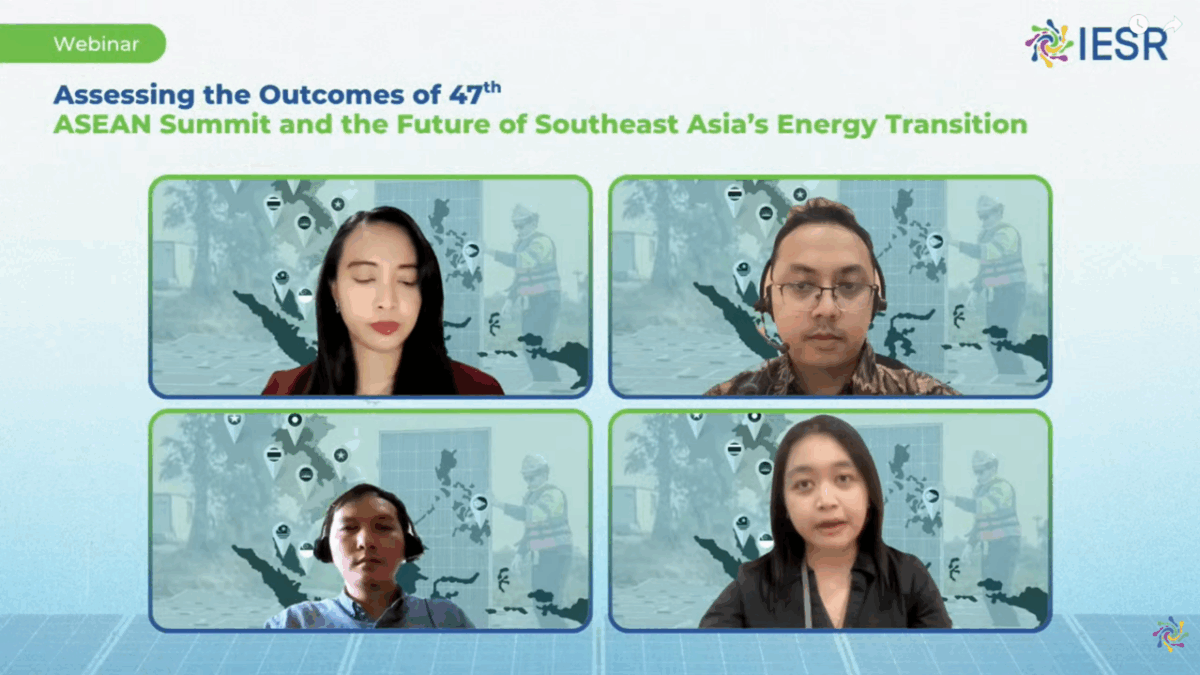Jakarta, November 6, 2025 – The UN Emission Gap Report 2025 states that, with current climate commitments from all countries worldwide, global warming is still on track to lead to a temperature rise of 2.2–2.5 degrees by 2100. Southeast Asia, as one of the fastest-growing economic regions, is also the region most impacted by the effects of global warming. If the ASEAN region does not take significant action to address the climate crisis, it will lose an average of 35–37 percent of its per capita income by 2050.
Arief Rosadi, Climate and Energy Diplomacy Program Manager at the Institute for Essential Services Reform (IESR), in his remarks at the webinar “Assessing the Outcomes of the 47th ASEAN Summit and the Future of Southeast Asia’s Energy Transition,” stated that ASEAN has the potential to champion the climate agenda in the region. One example is the ASEAN Joint Statement for the UNFCCC, which has been in effect since 2014. The ASEAN Summit in June 2025 issued the ASEAN 2045 Vision: “Our Shared Future,” which aims to make the region a center of economic growth in the Asia-Pacific region. It recognizes that energy security, climate change, and the transition to a green economy are essential elements to achieve this vision.
“The use of renewable energy can be a solution that adds economic value to the region and contributes to global climate mitigation. By accelerating renewable energy, ASEAN could generate a GDP of around 13.1 trillion by 2050, or 3.4% greater growth than the business-as-usual (BAU) scenario, and create a new green workforce, around 6 million green jobs by 2030,” he said.
Arief added that without policy intervention, fossil fuels will dominate ASEAN’s energy sector until 2050, increasing the risk of stalled coal-fired power plant assets, estimated to cost between USD 100 and 123 billion, potentially placing ASEAN in a position of carbon lock-in.
The IESR recommends a series of actions to complement economic and energy transition initiatives in Southeast Asia: first, accelerating the integration and expansion of renewable energy capacity. Second, establishing ASEAN as a hub for clean energy trade and manufacturing. Third, accelerate green financing and investment mechanisms. Fourth, improving policy coordination and developing a green workforce.
Irvan Tengku Harja, Program Manager & Research Lead for Just Energy Transition and Climate Action at The Habibie Center, stated that progress has been made in recognizing the urgency of transitioning to a cleaner energy system (a just energy transition), as evidenced by the explicit inclusion of just transition clauses in ASEAN agreement documents.
“However, one thing that must be understood is that the documents resulting from ASEAN meetings are not legally binding for member states. This can be seen as a weakness (because they lack legal force), but it is also an opportunity for each member states to redefine what is meant by ‘just’ and ‘inclusive’ according to their respective local contexts,” said Harja.
Novita Putri Rudiany, a lecturer at Pertamina University, added that the ASEAN region is facing megatrend challenges, encompassing major dynamics such as regional security crises, geo-economic pressures, and institutional cohesion.
“There are a number of gaps between the current situation and the ASEAN 2045 vision. For example, in the energy sector, ASEAN is currently dominated by fossil fuels, and structural challenges remain for sectoral decarbonization,” said Novita.
Novita added that to close this gap, in addition to continuing to urge ASEAN member governments and official organizations under ASEAN, civil society and all stakeholders are also encouraged to actively participate in monitoring and providing input to ASEAN.

